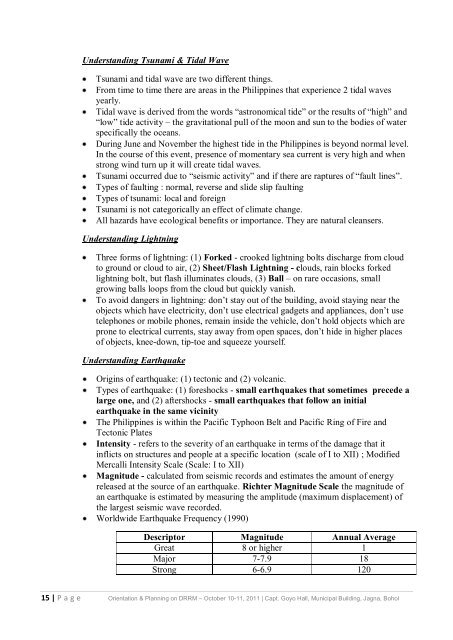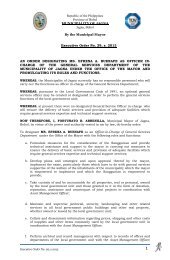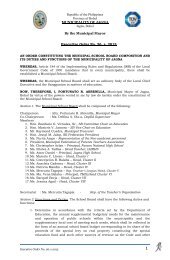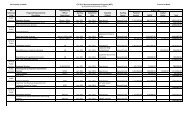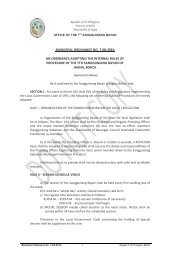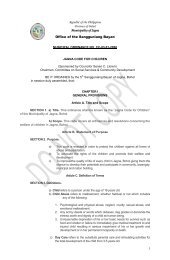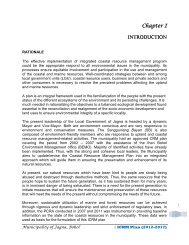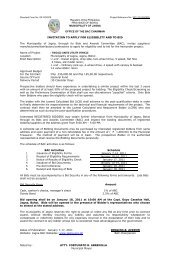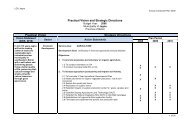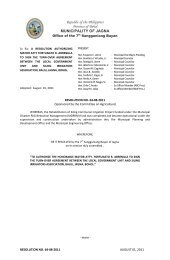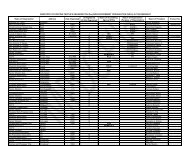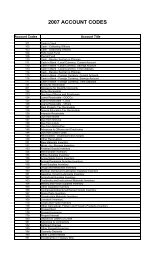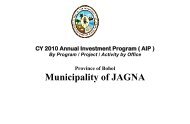DRRM Orientation to Punong Barangays of Jagna
DRRM Orientation to Punong Barangays of Jagna
DRRM Orientation to Punong Barangays of Jagna
Create successful ePaper yourself
Turn your PDF publications into a flip-book with our unique Google optimized e-Paper software.
Understanding Tsunami & Tidal Wave<br />
Tsunami and tidal wave are two different things.<br />
From time <strong>to</strong> time there are areas in the Philippines that experience 2 tidal waves<br />
yearly.<br />
Tidal wave is derived from the words “astronomical tide” or the results <strong>of</strong> “high” and<br />
“low” tide activity – the gravitational pull <strong>of</strong> the moon and sun <strong>to</strong> the bodies <strong>of</strong> water<br />
specifically the oceans.<br />
During June and November the highest tide in the Philippines is beyond normal level.<br />
In the course <strong>of</strong> this event, presence <strong>of</strong> momentary sea current is very high and when<br />
strong wind turn up it will create tidal waves.<br />
Tsunami occurred due <strong>to</strong> “seismic activity” and if there are raptures <strong>of</strong> “fault lines”.<br />
Types <strong>of</strong> faulting : normal, reverse and slide slip faulting<br />
Types <strong>of</strong> tsunami: local and foreign<br />
Tsunami is not categorically an effect <strong>of</strong> climate change.<br />
All hazards have ecological benefits or importance. They are natural cleansers.<br />
Understanding Lightning<br />
Three forms <strong>of</strong> lightning: (1) Forked - crooked lightning bolts discharge from cloud<br />
<strong>to</strong> ground or cloud <strong>to</strong> air, (2) Sheet/Flash Lightning - clouds, rain blocks forked<br />
lightning bolt, but flash illuminates clouds, (3) Ball – on rare occasions, small<br />
growing balls loops from the cloud but quickly vanish.<br />
To avoid dangers in lightning: don’t stay out <strong>of</strong> the building, avoid staying near the<br />
objects which have electricity, don’t use electrical gadgets and appliances, don’t use<br />
telephones or mobile phones, remain inside the vehicle, don’t hold objects which are<br />
prone <strong>to</strong> electrical currents, stay away from open spaces, don’t hide in higher places<br />
<strong>of</strong> objects, knee-down, tip-<strong>to</strong>e and squeeze yourself.<br />
Understanding Earthquake<br />
Origins <strong>of</strong> earthquake: (1) tec<strong>to</strong>nic and (2) volcanic.<br />
Types <strong>of</strong> earthquake: (1) foreshocks - small earthquakes that sometimes precede a<br />
large one, and (2) aftershocks - small earthquakes that follow an initial<br />
earthquake in the same vicinity<br />
The Philippines is within the Pacific Typhoon Belt and Pacific Ring <strong>of</strong> Fire and<br />
Tec<strong>to</strong>nic Plates<br />
Intensity - refers <strong>to</strong> the severity <strong>of</strong> an earthquake in terms <strong>of</strong> the damage that it<br />
inflicts on structures and people at a specific location (scale <strong>of</strong> I <strong>to</strong> XII) ; Modified<br />
Mercalli Intensity Scale (Scale: I <strong>to</strong> XII)<br />
Magnitude - calculated from seismic records and estimates the amount <strong>of</strong> energy<br />
released at the source <strong>of</strong> an earthquake. Richter Magnitude Scale the magnitude <strong>of</strong><br />
an earthquake is estimated by measuring the amplitude (maximum displacement) <strong>of</strong><br />
the largest seismic wave recorded.<br />
Worldwide Earthquake Frequency (1990)<br />
Descrip<strong>to</strong>r Magnitude Annual Average<br />
Great 8 or higher 1<br />
Major 7-7.9 18<br />
Strong 6-6.9 120<br />
15 | P a g e <strong>Orientation</strong> & Planning on <strong>DRRM</strong> – Oc<strong>to</strong>ber 10-11, 2011 | Capt. Goyo Hall, Municipal Building, <strong>Jagna</strong>, Bohol


